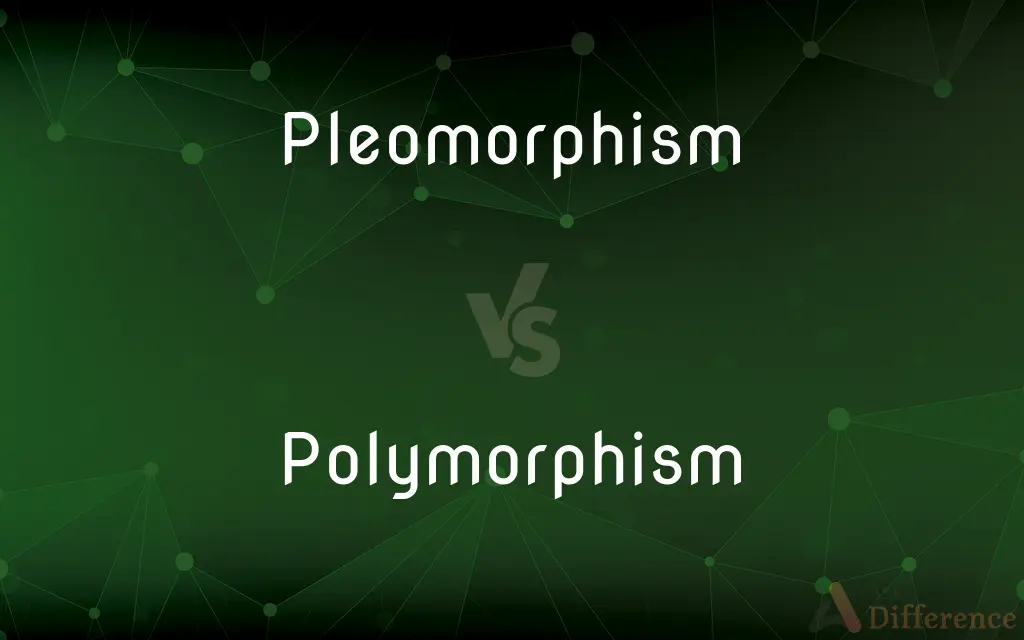Pleomorphism vs. Polymorphism — What's the Difference?
Edited by Tayyaba Rehman — By Urooj Arif — Updated on May 3, 2024
Pleomorphism refers to the ability of some microorganisms to alter their shape or size in response to environmental conditions, whereas polymorphism involves the occurrence of two or more distinct forms among individuals of a biological species.

Difference Between Pleomorphism and Polymorphism
Table of Contents
ADVERTISEMENT
Key Differences
Pleomorphism is typically observed in microorganisms, such as bacteria and fungi, which can change shape or size in response to environmental changes. On the other hand, polymorphism is a broader concept seen in various species, including plants and animals, where individuals differ in genetic traits, physical form, or behavior.
In pleomorphism, the changes in form are often a survival strategy, allowing organisms like bacteria to evade immune responses. Whereas, polymorphism often occurs as a result of genetic variation and can lead to different physical forms or behaviors that may have evolutionary advantages.
Pleomorphism can be induced by external factors such as nutrients, temperature, or the presence of antibiotics. In contrast, polymorphism is usually genetically determined and can be maintained in a population over many generations.
While pleomorphism is mostly limited to single organisms changing their forms, polymorphism can involve complex patterns of inheritance and expression of different alleles at a specific locus.
Pleomorphism in pathogens can complicate the diagnosis and treatment of diseases, as these organisms may not always be recognized by the same diagnostic tests. Polymorphism, however, can contribute to the diversity within a species that might aid in its survival under changing environmental conditions.
ADVERTISEMENT
Comparison Chart
Definition
Ability of an organism to change form
Occurrence of different forms among individuals
Scope
Mostly microorganisms
Various biological species
Trigger
Environmental conditions
Genetic variation
Purpose
Survival strategy
Evolutionary advantages
Impact on Species
Individual organism adaptation
Species-wide diversity
Compare with Definitions
Pleomorphism
Variation in size and shape among cells of a single species.
Pleomorphism in cancer cells can complicate treatment strategies.
Polymorphism
A condition where a gene exists in two or more alleles within a population.
Sickle cell anemia is caused by a polymorphic gene variant that alters hemoglobin.
Pleomorphism
Ability of an organism to exhibit multiple physical forms.
Some bacteria display pleomorphism depending on the nutrient availability in their environment.
Polymorphism
The presence of multiple distinct forms in a species that do not intergrade.
Polymorphism in the lizard species can result in different color morphs that are genetically determined.
Pleomorphism
The occurrence of more than one distinct form of disease-causing agents in a host.
Pleomorphism in the fungal genus Candida leads to different infection types.
Polymorphism
A survival strategy where diversity within a species can lead to greater adaptability.
Color polymorphism in peppered moths during the industrial revolution provided camouflage from predators.
Pleomorphism
A phenotypic variability that can confuse microbiological identification.
Due to pleomorphism, traditional staining techniques sometimes fail to identify specific bacteria.
Polymorphism
The occurrence of two or more clearly different morphs or forms, also referred to as alternative phenotypes, in the population of a species.
The butterfly species Papilio polytes exhibits polymorphism with different wing patterns.
Pleomorphism
A characteristic of certain pathogens to adapt physically to evade immune detection.
Bacterial pleomorphism can render some vaccines less effective.
Polymorphism
Genetic variation leading to different phenotypes within the same species.
Polymorphism in human blood types is a well-known example of genetic diversity.
Pleomorphism
(Chemistry) See polymorphism.
Polymorphism
(Biology) The occurrence of more than one form, as several alleles of a particular gene or winged and wingless forms of the same species.
Pleomorphism
(Biology) The occurrence of two or more distinct forms, as of an organism during its life cycle or of cells of a certain type.
Polymorphism
(Chemistry) Crystallization of a compound in at least two distinct forms. Also called pleomorphism.
Pleomorphism
(biology) the occurrence of multiple structural forms during the life cycle of an organism
Polymorphism
The ability to assume different forms or shapes.
Pleomorphism
(chemistry) polymorphism
Polymorphism
(object-oriented programming) The feature pertaining to the dynamic treatment of data elements based on their type, allowing for an instance of a method to have several definitions. en
Pleomorphism
The property of crystallizing under two or more distinct fundamental forms, including dimorphism and trimorphism.
Polymorphism
The property of certain typed formal systems of allowing for the use of type variables and binders/quantifiers over those type variables; likewise, the property of certain expressions (within such typed formal systems) of making use of at least one such typed variable.
Pleomorphism
The theory that the various genera of bacteria are phases or variations of growth of a number of Protean species, each of which may exhibit, according to undetermined conditions, all or some of the forms characteristic of the different genera and species.
Polymorphism
(crystallography) The ability of a solid material to exist in more than one form or crystal structure; pleomorphism.
Pleomorphism
(chemistry) the existence of different kinds of crystal of the same chemical compound
Polymorphism
(genetics) The regular existence of two or more different genotypes within a given species or population; also, variability of amino acid sequences within a gene's protein.
Pleomorphism
(biology) the appearance of two or more distinctly different forms in the life cycle of some organisms
Polymorphism
Same as Pleomorphism.
Polymorphism
The capability of assuming different forms; the capability of widely varying in form.
Polymorphism
(chemistry) the existence of different kinds of crystal of the same chemical compound
Common Curiosities
What is pleomorphism?
Pleomorphism is the ability of an organism, particularly microorganisms, to change their shape or size in response to environmental conditions.
What are examples of polymorphism in animals?
Examples include color variations in birds’ feathers and different shell forms in snails.
Can pleomorphism occur in human cells?
Yes, pleomorphism can occur in human cancer cells, often leading to variations in tumor morphology.
What is polymorphism in biology?
Polymorphism refers to the presence of two or more distinct forms within a population of a species, often due to genetic variability.
How does pleomorphism affect disease treatment?
Pleomorphism can make it difficult to diagnose and treat diseases, as the pathogens may not consistently present the same characteristics.
How does polymorphism benefit a species?
Polymorphism can enhance the survival and adaptability of a species by allowing individuals to thrive in diverse environments.
Are all forms of polymorphism visible?
Not all; some polymorphisms, like blood type, are genotypic and may not have direct phenotypic expressions.
What role does genetic drift play in polymorphism?
Genetic drift can increase or decrease the frequency of different forms within a population, affecting polymorphism.
How is pleomorphism detected?
It can be detected through microscopic examination and other molecular biology techniques.
Does polymorphism affect an individual's fitness?
It can, depending on the environment; for example, certain genetic variations might confer advantages under specific circumstances.
Can polymorphism lead to speciation?
Yes, in some cases, polymorphism can lead to reproductive isolation and eventually speciation.
Is pleomorphism always pathological?
No, while often associated with pathogens, pleomorphism can be a normal adaptation in some benign microorganisms.
How do researchers study polymorphism in the wild?
Researchers use genetic markers and phenotypic studies to investigate the distribution and effects of polymorphic traits in natural populations.
What causes pleomorphism in bacteria?
Factors such as changes in the growth medium, pH levels, and the presence of antibiotics can induce pleomorphism.
How is pleomorphism related to antibiotic resistance?
Some pleomorphic bacteria can change forms to evade the effects of antibiotics, leading to resistance.
Share Your Discovery

Previous Comparison
Dear vs. Sweet
Next Comparison
Biryani vs. CurryAuthor Spotlight
Written by
Urooj ArifUrooj is a skilled content writer at Ask Difference, known for her exceptional ability to simplify complex topics into engaging and informative content. With a passion for research and a flair for clear, concise writing, she consistently delivers articles that resonate with our diverse audience.
Edited by
Tayyaba RehmanTayyaba Rehman is a distinguished writer, currently serving as a primary contributor to askdifference.com. As a researcher in semantics and etymology, Tayyaba's passion for the complexity of languages and their distinctions has found a perfect home on the platform. Tayyaba delves into the intricacies of language, distinguishing between commonly confused words and phrases, thereby providing clarity for readers worldwide.
















































